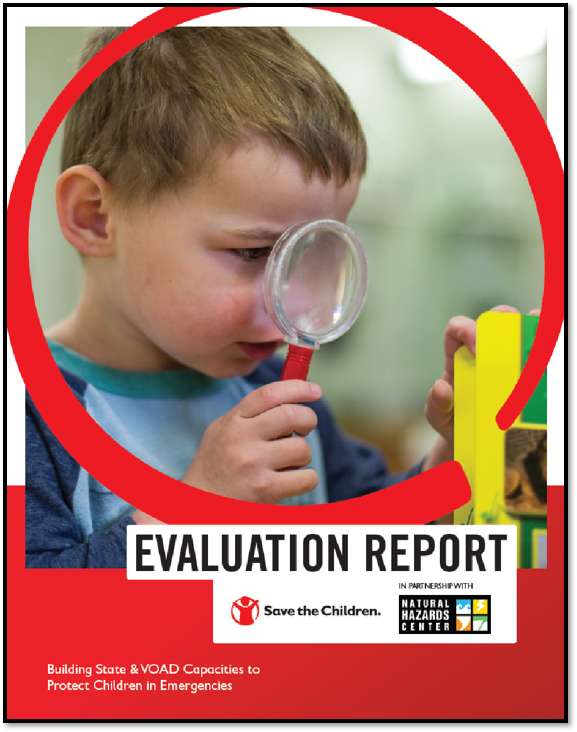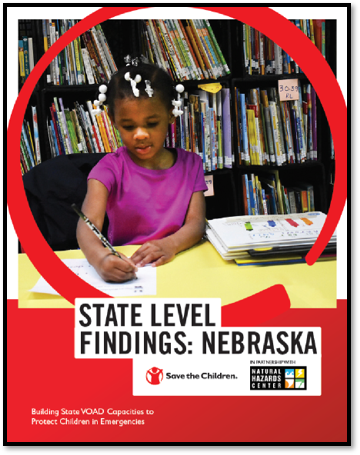State-level Voluntary Organizations Active in Disaster (VOADs) often provide critical support to children and their families, including linking them to recovery services they need and advocating on their behalf. Although VOADs can help reduce the harm children experience from disasters, until recently we didn’t have a lot of information about their capacity to do this work.
The Natural Hazards Center, in partnership with Save the Children U.S. Programs, has recently released an evaluation report that addresses this gap.
The evaluation—which was conducted collaboratively with state-level VOADs in Nebraska and Arkansas—showed that the VOADs were committed to responding to the needs of children and their families, but they faced several constraints, such as needing more funds, staff, child-specific disaster training, collaboration, and resource sharing to increase their ability to serve children. The project also showed that a lack of rural community representation in state-level VOAD structures could leave rural children at risk of being underserved.
“Our goal was to understand the role of VOADs in advancing child protection efforts,” said Natural Hazards Center Director Lori Peek, who was the principal investigator on the project. “We now know much more about how VOADs act during disasters to protect children, and we have identified a number of opportunities to further enhance their capacities to do so.”
Based on the evaluation findings, the report includes state-level indicators and recommendations to help VOADs meet the needs of children in disaster. Policymakers, organization leaders, and others concerned with increasing the capacity of state-level VOADs can use the state-level indicators to assess preparedness and encourage action.

The project also developed a set of tools and resources that VOADs and child-serving organizations can use to identify strengths, challenges, and ways to improve their ability to meet children’s needs in disaster. In addition to informing ways that individual VOADs can enhance their capacities, the tools also provide useful suggestions for ways VOADs can collaborate and create a robust network of emergency management and child-focused organizations to better support children.
The final report, as well as state-level findings from Arkansas and Nebraska are the culmination of a two-year formative and outcome evaluation that took place between 2018 and 2020. The work was completed using surveys, participatory asset mapping exercises, interactive GIS maps, and social network analyses.
"Working with the state-level VOADs in Arkansas and Nebraska was such a rewarding experience,” said Jamie Vickery, a former Natural Hazards Center research associate who served as the lead evaluator on the project. “The conversations VOAD members had with one another during the participatory asset mapping activities were particularly striking, as they were so thoughtful in identifying their organizations' assets and gaps in the context of disaster response.”
The Natural Hazards Center project is part of a decade-long Save the Children U.S. effort to encourage states and local governments to implement the 81 recommendations the National Commission on Children and Disasters set out in its 2010 report to Congress.
Additional information about the project, the final report, and two state-level reports can be found on the project webpage.


